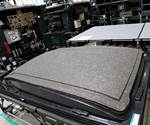Recycled carbon fiber update: The supply side
Commercial recyclers aren’t alone in their pursuit of fiber reclamation. Textile converters have joined the effort.
Commercial recyclers aren’t alone in their pursuit of fiber reclamation. Textile converters have joined the effort, enjoying a plentiful and secure supply of internally generated raw material.
FORMAX (Narborough, Leicestershire, U.K.), for example, is converting virgin fiber waste from its manufacture of noncrimp fabrics (NCF) into nonwoven mats that can be used in composite parts. According to Managing Director Oliver Wessely, waste such as edge trim is cut off, sucked into a vacuum and converted into a discontinuous fiber sheet, which “can then be used as a print-stop barrier or bulking layer in infused marine or architectural parts, for example.” FORMAX is also developing materials for use in Class A surface automotive parts. “The discontinuous fibers produce absolutely no print-through,” claims Wessely, “and also enable good formability for parts with complex geometry.” He asserts the material processes well in press molding and would be ideal for fabricators who currently use sheet molding compound (SMC). “It can produce very good properties depending upon the resin and process used,” he claims, ”and is being trialed now at a number of our automotive customers who are expressing great interest.”
With current production at 700 metric tonnes of carbon fabric annually (over 1.5 million lb/yr), and 7 percent waste, Wessely says FORMAX already has a good supply, “but as we grow this will only increase. Also, our customers are typically generating 25 percent waste from nesting as they cut out plies prior to preforming and/or laying and we also run this through our process.” He says the company is now transitioning from lab scale to commercialization. Fiber lengths range between 50 and 75 mm (2 and 3 inches), with the original applied sizing intact, and the resulting textile reportedly drapes and handles like a heavy veil.
Likewise, Sigmatex (Norton, Cheshire, U.K.) is also collecting dry carbon fiber production scrap — discontinuous virgin fibers mainly between 45 and 60 mm (1.8 to 2.4 inches) long — which it then combines with thermoplastic and weaves into tapes or noncrimp fabric (NCF) with more than 60 percent tensile strength and 90 percent modulus vs. VCF fabric at a lower price. “We worked with the U.K. government-funded FiberCycle program, where the aim was to develop this for large-scale composite applications,” says commercial manager Mike Hitchen. He notes that these RCF products are marginally cheaper than NCF using the most cost-effective virgin fibers, but that real cost reduction is achieved through reduced part cycle time through heated press stamping and the removal of resin from the manufacturing process. The first commercial SigmaRF product is a ±45 biaxial 220 g/m2 (6.5 oz/yd2) NCF. It contains 3 percent PET stitching thread and is 48 percent CF by weight. Sigmatex has sold the fabric into press-molded parts for an automotive component and also developed options using polyamide (PA), polyethersulfone (PES) and polyetherimide (PEI).
Editor's note: This short article is a sidebar to a feature article titled "Recycled Carbon fiber update: Closing the CFRP Lifecycle Loop." To read the main article, click on its title under "Editor's Picks," at top right.
Related Content
Ceramic matrix composites: Faster, cheaper, higher temperature
New players proliferate, increasing CMC materials and manufacturing capacity, novel processes and automation to meet demand for higher part volumes and performance.
Read MoreFirst Airbus A350 crash confirmed in Haneda
Shortly after touch-down, a JAL A350-900 aircraft recently collided with a De Havilland Canada Dash 8. Exact circumstances are still unknown.
Read More“Structured air” TPS safeguards composite structures
Powered by an 85% air/15% pure polyimide aerogel, Blueshift’s novel material system protects structures during transient thermal events from -200°C to beyond 2400°C for rockets, battery boxes and more.
Read MoreDevelopment of a composite liquid hydrogen tank for commercial aircraft
Netherlands consortium advances cryogenic composites testing, tank designs and manufacturing including AFP, hybrid winding, welding of tank components and integrated SHM and H2 sensors for demonstrators in 2025.
Read MoreRead Next
Recycled carbon fiber update: Closing the CFRP lifecycle loop
Commercial production of recycled carbon fiber currently outpaces applications for it, but materials characterization and new technology demonstrations promise to close the gap.
Read MoreUltrasonic welding for in-space manufacturing of CFRTP
Agile Ultrasonics and NASA trial robotic-compatible carbon fiber-reinforced thermoplastic ultrasonic welding technology for space structures.
Read MoreScaling up, optimizing the flax fiber composite camper
Greenlander’s Sherpa RV cab, which is largely constructed from flax fiber/bio-epoxy sandwich panels, nears commercial production readiness and next-generation scale-up.
Read More


























